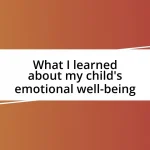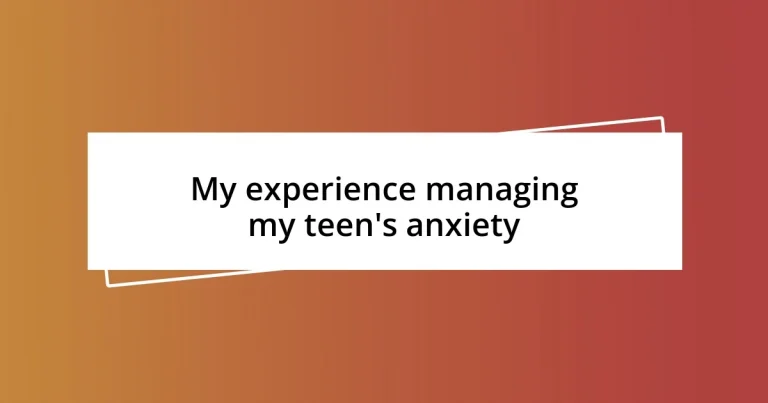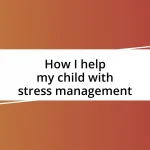Key takeaways:
- Recognizing and understanding subtle signs of anxiety in teens, such as changes in behavior and physical symptoms, is crucial for parents to identify and address underlying issues.
- Establishing effective communication, including active listening and non-verbal cues, fosters a safe environment for teens to express their feelings and concerns.
- Involving professionals, creating a supportive home environment, and monitoring progress can significantly aid in managing teen anxiety, emphasizing the importance of collaboration and adaptability in the treatment process.
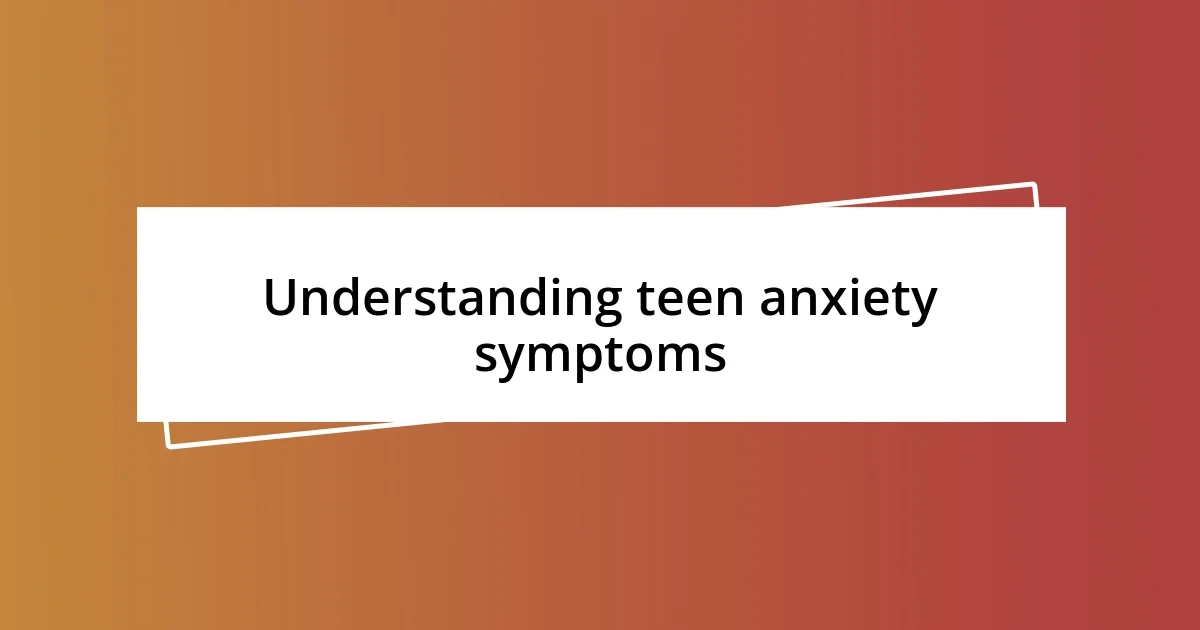
Understanding teen anxiety symptoms
When I first noticed my teen was having difficulties, it was the subtle signs that caught my attention. Changes in sleep patterns, irritability, or even withdrawing from activities they once loved can often mask deeper issues. How many parents might overlook these signs, thinking it’s just a phase or typical teenage behavior?
I remember a specific night when my child, usually so chatty, sat silently at dinner, fingers fidgeting with their plate. It struck me then that anxiety often wears a cloak of normalcy. Many teens might not openly express their struggles, so as a parent, it’s essential to tune into those quieter moments and connect the dots.
Physical symptoms can also play a significant role in understanding teen anxiety. Complaints about stomach aches or headaches, which seemed trivial at first, turned out to be a manifestation of my teen’s anxiety. How can we help them if we only see the symptoms on the surface? Recognizing the intertwining of emotional and physical experiences was a pivotal point in our journey.
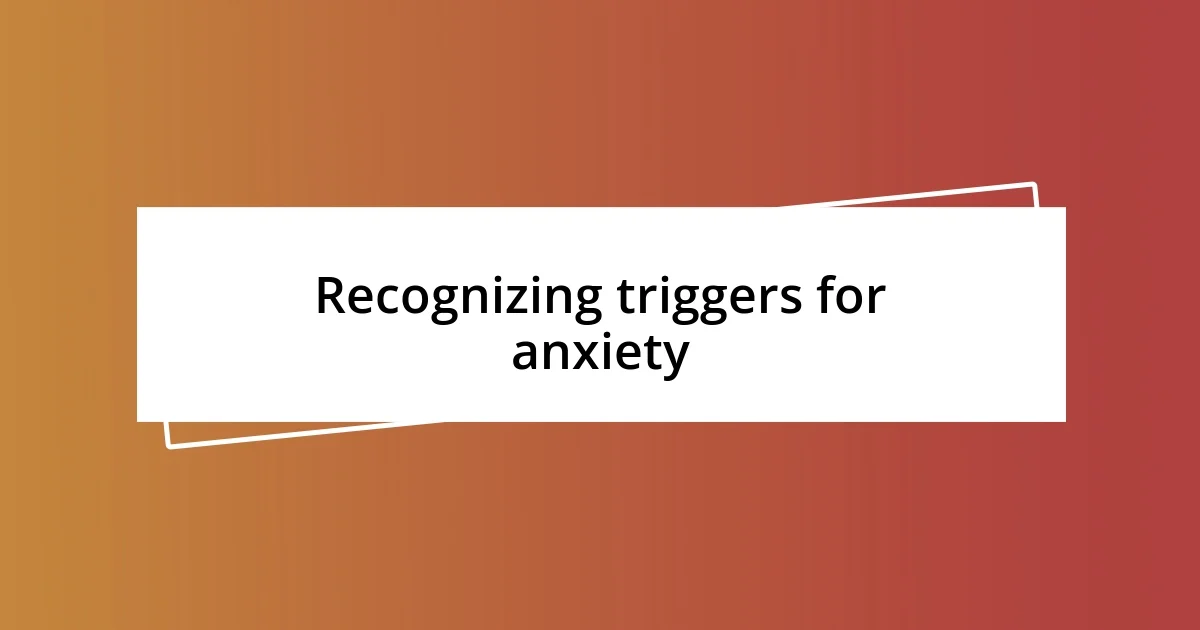
Recognizing triggers for anxiety
When I took the time to observe closely, I began to identify the specific situations that triggered my teen’s anxiety. It was often related to school stress—those looming deadlines and social dynamics can really weigh heavily on a young mind. I noticed that during exam periods, the tension in our household escalated, leading to tearful moments that were hard to watch. That’s when I realized the importance of open dialogue about what was causing that stress.
To help pinpoint triggers, I started keeping a simple journal that tracked different situations along with my teen’s reactions. Here are some common triggers I discovered:
- Academic Pressure: Tests, projects, or even class participation can create anxiety.
- Social Interactions: Friendships, isolation, or conflicts can evoke strong emotions.
- Family Dynamics: Changes at home, like a divorce or moving, can heighten tension.
- Uncertainty About the Future: Questions about college or career paths can loom large.
- Online Activity: Social media interactions might lead to comparison and feelings of inadequacy.
Being aware of these triggers became a game changer for us. It allowed for proactive conversations and strategies to help my teen cope effectively.
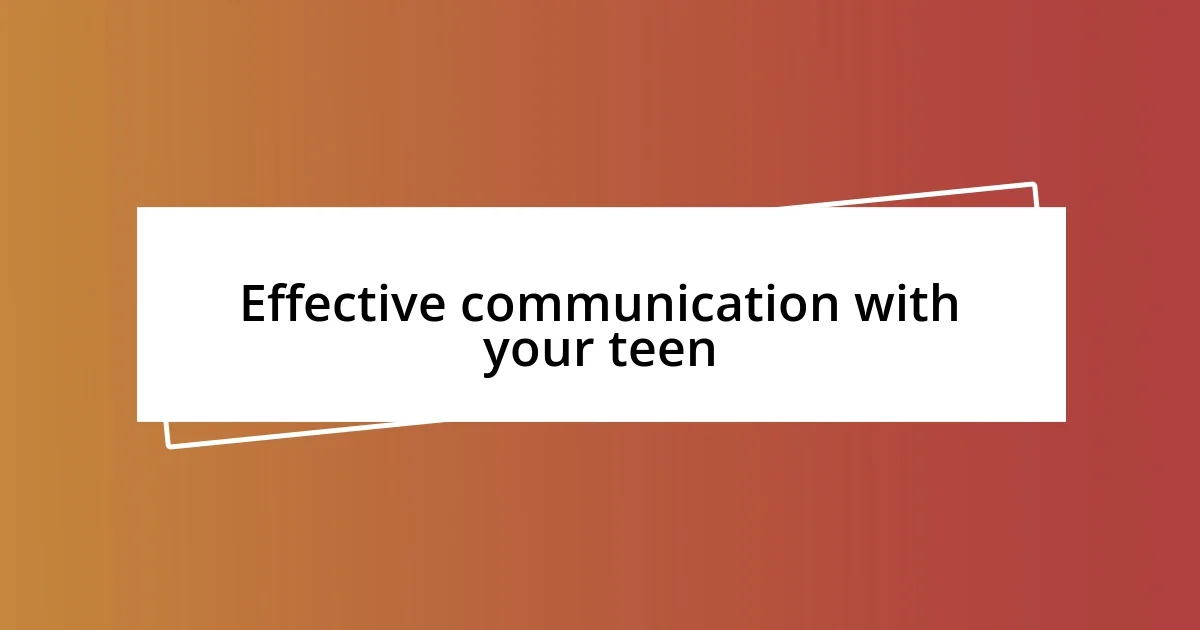
Effective communication with your teen
When it came to effective communication with my teen, I quickly learned that listening was more important than talking. One evening, I put my phone down and simply asked my child, “What’s on your mind?” The floodgates opened. I realized that creating an open space where they felt safe to share was key. It’s amazing how a simple question can lead to a deeper connection.
I also discovered that body language plays a crucial role in our conversations. I made it a point to maintain eye contact and put aside distractions during our talks. One afternoon, while discussing their feelings about school, I noticed my teen’s posture relax. This physical openness mirrored their willingness to share more. I now see how non-verbal cues can either enhance or stifle communication.
Establishing a routine check-in time proved beneficial as well. I remember one Sunday afternoon, we made it a habit to sit down over hot chocolate and talk about the week. This regularity turned those conversations into something my teen looked forward to. It became a space where worries were less daunting, further solidifying our bond.
| Communication Strategy | Description |
|---|---|
| Active Listening | Prioritize listening over talking, creating an open space for sharing. |
| Non-Verbal Cues | Maintain eye contact and stay present to encourage openness. |
| Routine Check-Ins | Schedule regular times to talk, providing a safe environment. |
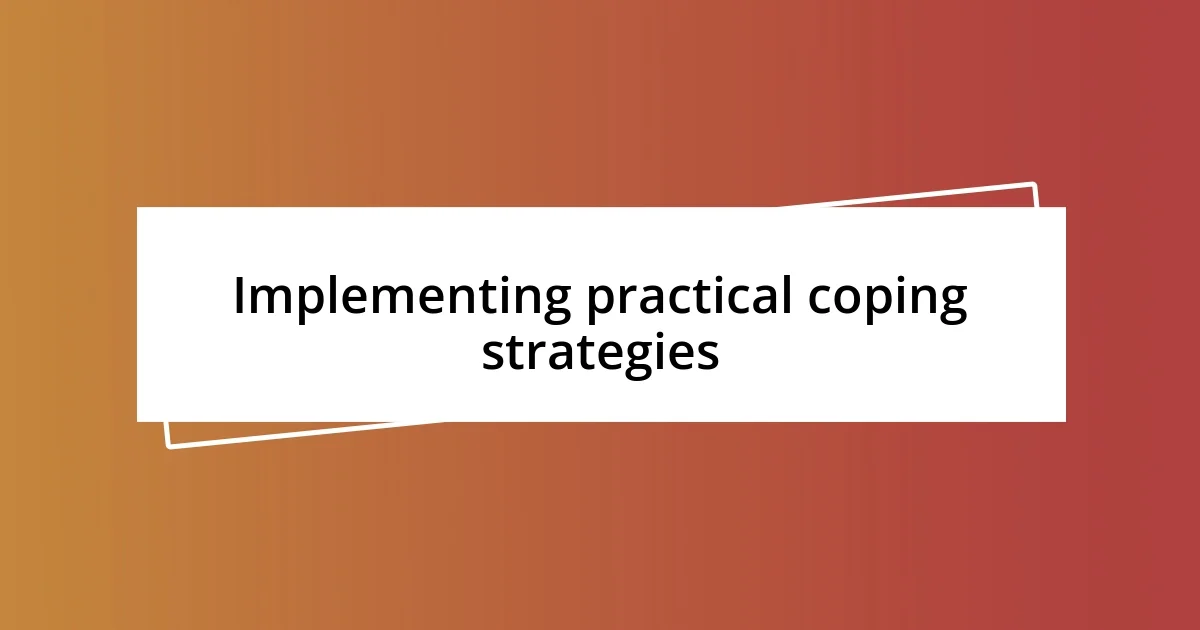
Implementing practical coping strategies
One of the most effective coping strategies I implemented was introducing mindfulness techniques into our daily routine. For instance, we began practicing short meditation sessions together after school. I remember the first time we tried it; my teen was skeptical, but after just ten minutes of focused breathing, I noticed their fidgeting ease into calmness. It was a small investment of time that paid off immensely, and it got me wondering—how often do we overlook such simple, yet impactful practices?
Breathing exercises also became a go-to tool for managing anxiety. I vividly recall a moment during a particularly stressful homework session where my teen felt overwhelmed. We paused, took a few deep breaths together, and I suggested counting to four while inhaling and exhaling. The relief on their face was palpable; it was like lifting a heavy weight off their shoulders. Who knew something as fundamental as breathing could be so transformative?
Incorporating physical activity was another powerful strategy. I decided to take regular walks together in the evenings, just to talk and unwind. On one such occasion, my teen opened up about a tough day at school while we strolled through the neighborhood park. I found that being outdoors, away from screens and homework, allowed for a more relaxed conversation. This made me wonder: could something as simple as a walk change the way we relate to one another during stress?
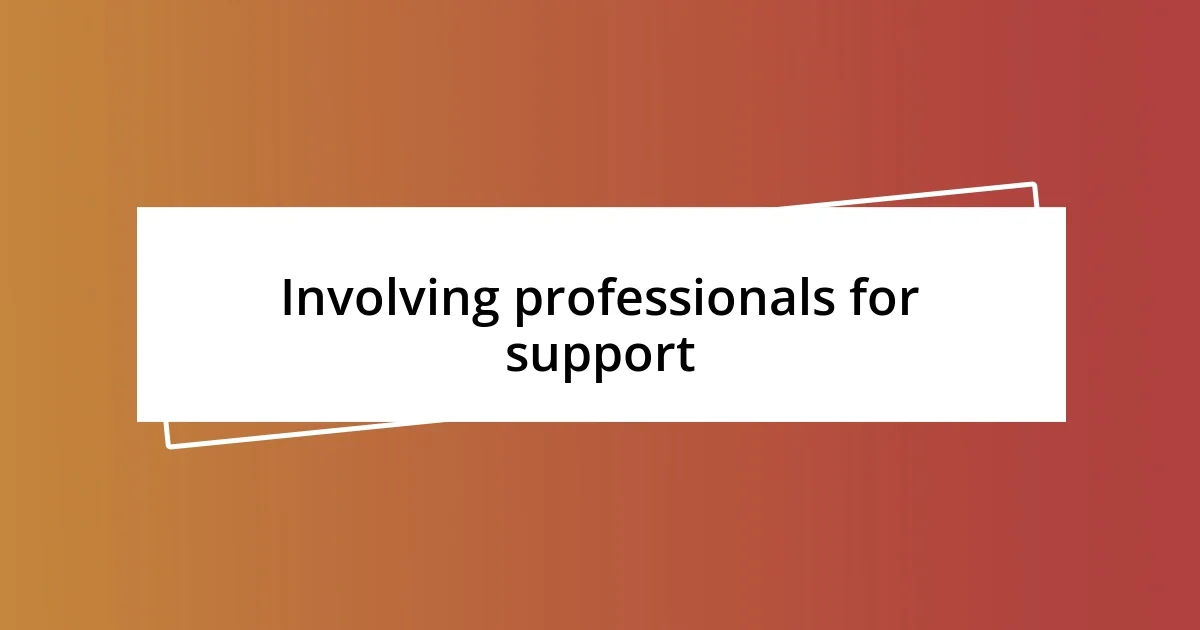
Involving professionals for support
Involving professionals became a pivotal step in our journey. I remember the first time we visited a therapist together—it felt intimidating, but also like a leap toward understanding my teen’s anxiety. The therapist taught us both valuable skills, like cognitive-behavioral techniques, which challenged negative thought patterns. I found this professional insight invaluable because it provided structured support outside our home.
I wasn’t sure what to expect from medication, but after discussing options with a pediatric psychiatrist, I saw immediate benefits for my teen. The doctor explained how certain medications work to balance brain chemistry, which was mind-opening to me. Watching my teen gradually feel more stable and less overwhelmed by daily stressors was nothing short of a relief. It made me wonder how often families shy away from considering medication as part of treatment—sometimes it really can make a significant difference.
Another support avenue that came into play was involving the school counselor. I recall my teen’s anxiety peaking during exam periods, and the counselor was fantastic in providing coping strategies tailored to their learning environment. Together, we set up accommodations like extended time on tests, which alleviated a lot of pressure. This experience showed me the importance of a collaborative approach—having a dedicated professional in the school made them feel safer and more confident in facing their challenges.
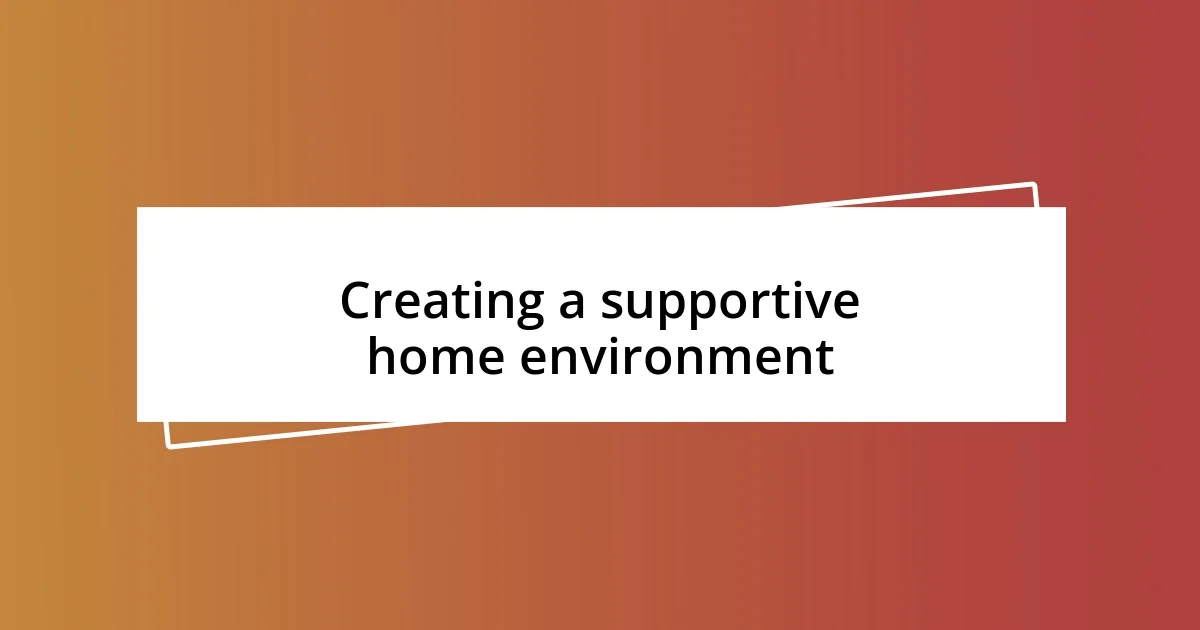
Creating a supportive home environment
Creating a supportive home environment was crucial in helping my teen navigate their anxiety. I transformed our living space to feel more tranquil—incorporating soft lighting and cozy corners for quiet time. I remember my teen curling up in one of those nooks with a book, their body language shifting from rigid to relaxed. This small change made me realize that sometimes, the right environment can foster safety and open communication.
I also emphasized the importance of family rituals that encouraged connection and support. For instance, we initiated a weekly family night where we would cook dinner together and share our highs and lows from the week. I can still hear my teen’s laughter from that night when we attempted to make homemade pizza—it became a cherished tradition that allowed us to discuss anxious moments in a relaxed atmosphere. Wasn’t it surprising how laughter could be such a balm for stress?
Creating open lines of communication was equally vital. I made it a point to check in with my teen regularly, asking how they were feeling without judgment or pressure. On one occasion, during a casual car ride, my teen suddenly opened up about their worries regarding friendships. I felt a rush of gratitude—a reminder that being present and approachable can encourage honest conversations. In those moments, I learned that the simple act of listening can be a powerful antidote to anxiety.
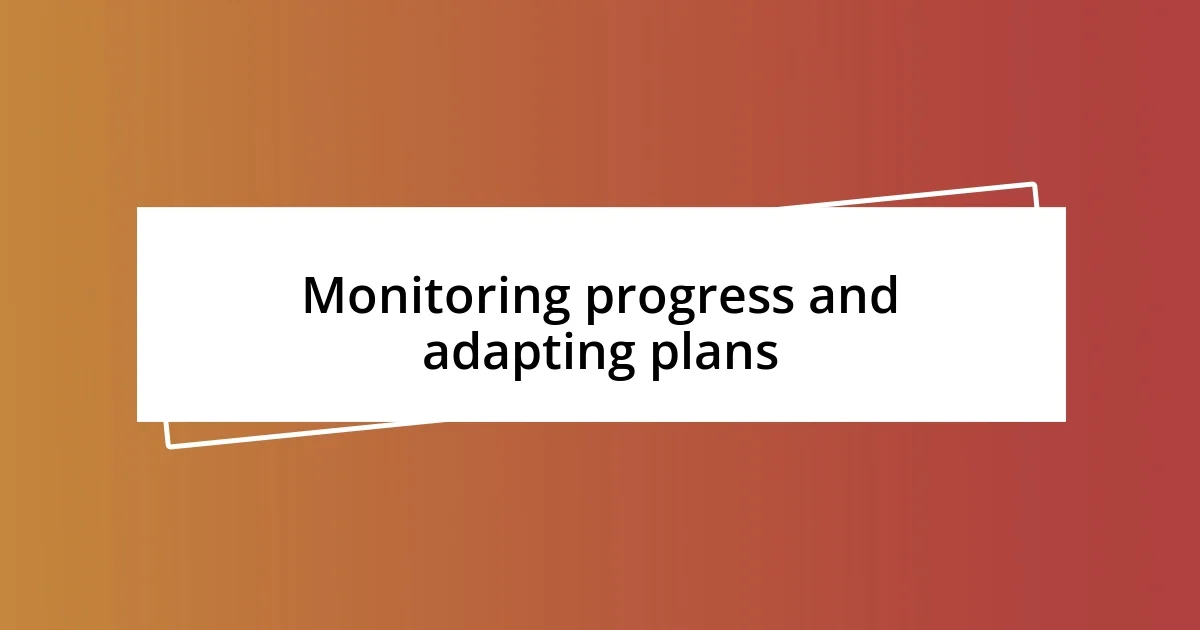
Monitoring progress and adapting plans
Monitoring my teen’s progress was an ongoing process that demanded both patience and flexibility. I often found myself jotting down notes after our therapy sessions, reflecting on what seemed to resonate and where my teen continued to struggle. It’s amazing how just a few weeks can reveal shifts in mood or anxiety levels—a simple observation like their eagerness to participate in social events instead of retreating could indicate significant strides. Have you ever thought about how small victories can accumulate into something monumental?
As we tracked their progress, I realized that adapting our plans was just as crucial as monitoring. There were times when an approach that once worked suddenly stopped being effective, like certain coping strategies taught by the therapist. I vividly remember a week when my teen expressed frustration with a breathing technique that had previously helped; instead of pushing it, we experimented with mindfulness exercises instead. This trial-and-error approach became a valuable lesson—being open to change not only empowered my teen but also gave them a sense of ownership in their journey.
Reflecting on our time together, I found that celebrating progress was just as important as adjusting our strategies. I started marking little milestones, like how my teen felt ready to try out for a school team after months of avoiding any kind of competition. I still smile when I think about that moment—sitting across the dinner table, their eyes sparkling with excitement. It reinforced my belief that recognizing progress, no matter how small, encourages resilience. Isn’t it remarkable how acknowledging even the tiniest steps forward can light a path through anxiety?










